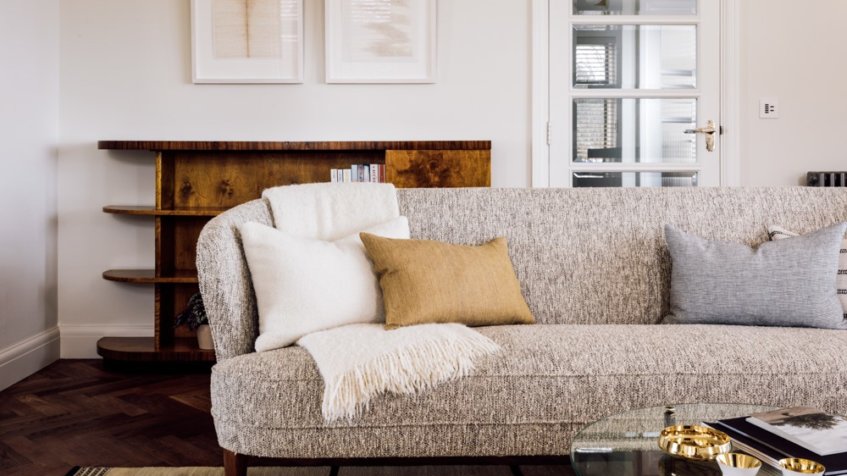BUILD’s Design Top 10 – Burchdaume
Burchdaume was first set up in 2013, under Director Alex Ford. Alex, who has worked in the interiors industry for more than 20 years, both on the retail side and in high-end residential design, has built the company to provide a dedicated Furniture, Fixtures and Equipment (FF&E) service, which provides residential interior design and conservancy to businesses and individuals, often as part of a client’s larger design team.
In explaining his approach to business, Alex demonstrates his experience by singling out the clientele that he aims to attract. ‘Clients want a personal service via their family office and a single point of contact. They do not always want a large established practice when something uniquely personal, practical and simple is what is required. ‘
‘These days, clients understand quite well what they want; they have all seen the best and latest product. This means that the detail and nuance in visual presentation is even more important. Deciding where creatively you want to position the clients project is crucial and not an easy decision to make or execute with precision.’
In response to this, Burchdaume focusses on building a strong creative narrative, often based on history, location or sensibility, combining the interests and requirements of the client and aligning those the original creative direction of Alex and his staff. ‘We tend to mix contemporary with antique or vintage, pulling together an interesting collection of pieces which are both relevant today and can make good long term investments. We deal with the personality driven elements of a home, research each project thoroughly to create warm, interesting rooms that reflect the story of the building and the client.
‘Ours is a specific skill set which can add a lot to the overall success of a project, but of course we interface with other contractors in the traditional way.’
With a strong focus on targeting a niche of customers demanding a more personal touch, Alex creates contrast between Burchdaume’s business model and that of its rivals. ‘Ultimately, what sets all design work apart is the handwriting of the designer. We, as a business, focus on a few clients who want a personal service, who want access to the designer throughout the project, not just at the first meeting – they expect a very tailored result. We are the best option for those clients, because we consider the creative narrative of the project in relation to the client probably in more depth than most. We build a story of the past and pull together a coherent collection that can be added to or rearranged in time.’
Indeed, some of Burchdaume’s most notable projects have required a flair for reimagining the décor of decades past. For their latest project, a 1930’s detached harbour-side house in the Channel Islands, refurbishment rather than rebuilding was the more expensive option, which the client considered well worth the effort.
‘We saved the original house and layout,’ he describes, ‘extending it with only a modest conservatory. We looked at Scandinavian and English furniture that described the dramatic period of change from the 1930s to the 1950s. Elements such as the sanitary ware were chosen because they were finished by hand so that they feel more tactile. We also mixed in vintage textiles for the same reason, just as the artwork by Julia Hutton, really shows the hand of the artist.
‘It is not what most people would have done, but it now has a renewed elegance and personality that will last for generations.’
While the company is based in London, most of Burchdaume’s projects take them outside of the city. Learning from working in new locations, ‘the more time we can have to immerse ourselves in the location, the better – that is clearly going to be a benefit, and I would say probably result in savings.’
That is not to say that London goes unnoticed, however. ‘We are currently working on a Central London townhouse; it is a more urbane project, with high sheen luxurious textiles and really contemporary fittings. We are using confident but simple colour palettes and continental furniture from the mid-1950s. We will mix periods, but usually one period, style or provenance will dominate.’
As more modern artistic forms continue to emerge in new architectural projects, there is a certain trade-off to be considered – balancing the old with the new is often an architect’s worst nightmare. To Alex, however, the opportunities this brings to inspire new, innovative solutions is a principal manner in which Burchdaume has achieved such success.
‘Obviously, we want to achieve progression and evolution on every project, developing strong narratives from our research and better understanding products and materials so we can use them to describe what we want to achieve for the client.
‘Of course, it is also necessary to work with the right clients, hence most of our work comes via recommendation.’
The future of Alex’s target market remains in fluctuation. While the long-term impact of Brexit remains unclear, indications point towards uncertainty in land and property values in the UK. The future for Burchdaume, however, according to Alex, is not overshadowed by such things.
‘There will be plenty of movement in property markets in Europe and the US; land management and the value of such land will occupy our minds even more acutely in the next few years. Those that can, may consider their portfolios also for enjoyment and preservation rather than short term investment and we think this will shape interior design development at our end of the market.
‘We are certainly open to speciality homes – mountain and waterfront in particular play to our strengths, but also smaller boutique hotels or activity hospitality would be a very interesting next avenue for us.’
Company: Burchdaume
Email: [email protected]
Phone: 020 8014 1445
Web Address: www.burchdaume.com
Address: 68c Kings Avenue, London, Greater London, SW4 8BH
































